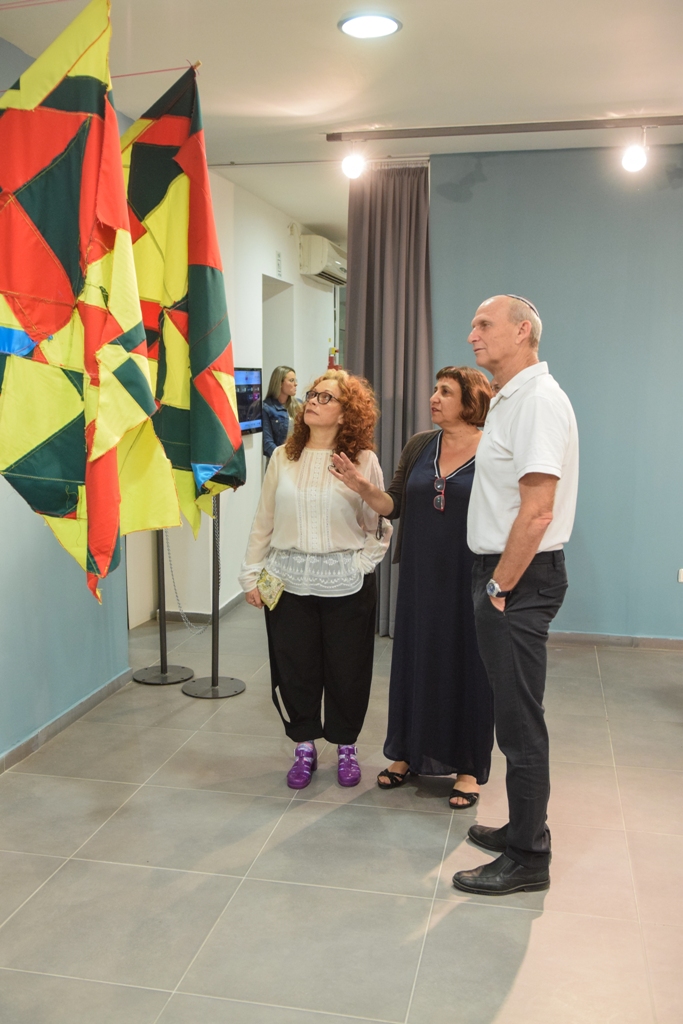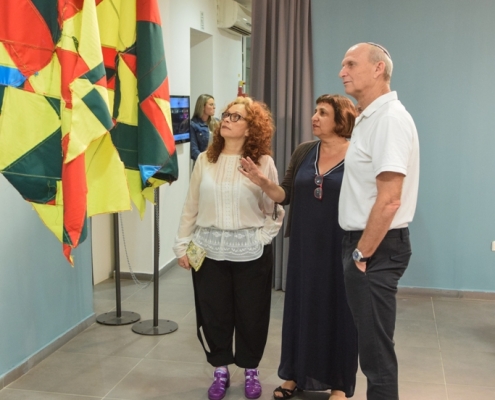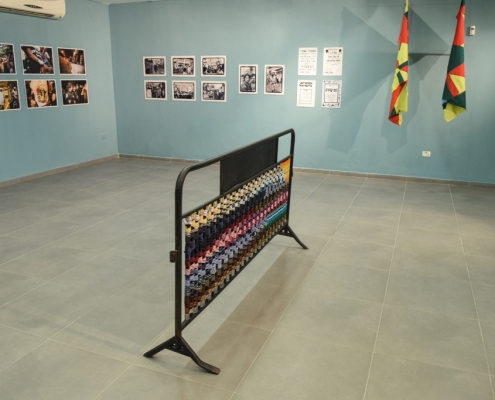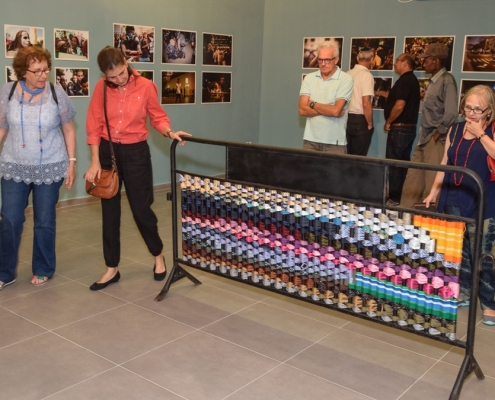איקס X – בעקבות מחאת יוצאי אתיופיה
*English follows below
התערוכה החדשה בסדנא לאמנות תערוכה חדשה מפנה מבט למאבק יוצאי אתיופיה. כותרת התערוכה – “איקס X” מאזכרת את מחוות הידיים המוצלבות בהפגנות וגם את פעולת הפסילה, בין אם מדובר בפסילת מנות דם או בפסילה של דיירים למגורים.
בתצוגה: מחסומי משטרה ארוגים (ענבל אגוז), דגלים צבעוניים גיאומטריים מעולם של טקסים ותהלוכות (גילי אבישר), חולצת טריקו גדולת ממדים (גרעין קהילתי ראשל”צ בשיתוף מעצבת האופנה אפרת בנדיסלאב) וסדרות של צילומים (גדעון אגז’ה ומאיר ויגודר).
החלק הארי בתצוגה יוקדש לסדרת עבודות של הצלם גדעון אגז’ה, שתיעד את מחאת הצעירים בגליה השונים: במחוות הפרפורמטיביות ובאמצעות הצלבת הידיים בצילומי המפגינים שלו, מסמנים המצולמים כי הם אינם חמושים ואינם אלימים.
לצד סדרות צילומי המחאה יוצגו צילומיו של מאיר ויגודר משנות ה-70. ויגודר תיעד את מאבק הפנתרים השחורים ואת העימותים עם רשויות החוק וחלק מצילומיו צולמו אף הם באותו אתר ממש של בניין עיריית ת”א. הצילומים יופיעו כמעין הערה תקופתית, המאפשרת להציב את המחאה הנוכחית בפרספקטיבה של זמן ומקום. הצבה כזו בוחנת את נקודות הדמיון והשוני בהתקבלות או אי התקבלות של קבוצה, בהדרה מצד החברה ובתחושת אי-שייכות, ואת היחסים עם מוסדות החוק.
מחאת יוצאי אתיופיה רלוונטית לילידי הארץ הוותיקים כיוון שהיא שבה לאתגר את מושג “כור ההיתוך”, אחד הערכים הטעונים עליהם מושתתת החברה הישראלית מאז הקמת המדינה. המחאה היא גם הזדמנות להאיר את הנקודות בהן נפרמים ומתערערים החוטים העדינים, הדמיוניים, שניסו לכרוך קבוצות אתניות שונות עם המדינה ומוסדותיה.
בשנים האחרונות עסקו תערוכות רבות בפוליטיקה של הצבע, בהגירה ובעולים בעיקר סביב סממנים של תרבות ומסורת. תערוכות אחרות עסקו במחוות של מחאה ומופעיה הגופניים והצורניים במרחב הציבורי. התערוכה הנוכחית אינה הערה כללית על גזענות, על אחרוּת או על שחורוּת, אך היא כן מפנה מבט לקבוצה מסוימת של אזרחים הנוכחים במרחב הישראלי בזמן נתון. הם צועדים וחוסמים כבישים, ממלאים את הכיכרות והרחובות. שאלת ההתקבלות והנראות במרחב הציבורי נפתחת מחדש כשהקבוצה כמו תובעת מחדש את מקומה במרחב.
בתקופה זו בה אנו ערים ל”טעויות” בזיהוי ולשיפוט מהיר, על פי מראה וצבע עור, בימים בהם טעות בזיהוי מובילה לאלימות ולהרג של חפים מפשע, נשאלת שאלה על נראות, על דמיון חזותי ועל שוני על נאמנותה של קבוצה. תערוכה זו מסמנת ומבליטה את אזורי העימות שנצבעים דרך צבע, מוצאת ובוחרת להעלות קונפליקטים כאקט דמוקרטי, כשהיא חותרת תחת טיוח ההבדלים והישראליות של כור ההיתוך.
גילי אבישר כתגובה למחאה, בחר לפרק את דגל אתיופיה לצורות גיאומטריות ומתייחס לדגלים הנלווים למחאות ולטקסים באשר הם. לצד השימוש בדגל ישראל בהפגנות, מופיעים במחאה האחרונה גם אזכורים של מפת אתיופיה. כך עולה הקונפליקט הקשור לזהות הלאומית הישראלית ולשאלת ההתקבלות כקבוצה.
ענבל אגוז ארגה עניבות וחלקי בדים על מחסומי משטרה ועירייה. אגוז חיבה בשכונת שפירא ואמה היא ילידת השכונה. אגוז מתייחסת, במחסום למערכות שלטוניות לגזענות בשכונת מגוריה ולמסורת הקשורה לבגדים ולטקסים. במחסום העירוני הכחול שיצרה מבד שיובא מאתיופיה, אורגת האמנית את צורות הדגל דווקא בלבן: מגן דוד ופסים באריגת “נגטיב” בה הכחול מופיע בלבן. שני המחסומים מוצבים בחלל כשהם חוסמים, מגדירים שטח ומנתבים תנועת מבקרים ומעבר.
פתיחה: 9.4.16, מוצאי שבת, 20:30
אוצרות: אורית חסון
אמנים: גדעון אגז‘ה, גילי אבישר, מאיר ויגודר, ענבל אגוז, סטודיו אפרת בסנדילאב וגרעין קהילתי ראשון לציון
X –An artistic response to the protest by the Ethiopian community
A new exhibition at the Ramat Eliyahu Art Workshop turns its gaze on the Ethiopian community’s struggle. The title, X, or “Ix, Ex,” is a reminder of the gesture of the crossed arms at the mass protests as well as “x-ing” someone out, nullifying them, whether referring to rejecting blood donations or rejecting potential tenants.
On view are woven police barricades by Inbal Egoz; colorful geometric flags inspired by ceremonies and parades, by Gili Avissar; “X-tra Large” T-shirts, by the Gar’in Kehillati Rishon Lezion (a community-based core group) in collaboration with fashion designer Efrat Besandilov; and series of photographs by Gidon Agaza and by Meir Wigoder.
The majority of the photographs on view are by photographer Gidon Agaza, who documented the protests by the young people of the Ethiopian community through various visual images: the protesters’ performative gestures and crossing the arms, symbolizing being unarmed and demonstrating peacefully not with violence.
Meir Wigoder’s photographs from the 1970s are exhibited along with Agaza’s more contemporary photographs. Wigoder documented protests by the Israeli Black Panthers and their confrontations with the law. Some of his photographs were filmed at the very same site – the Tel Aviv-Yafo Municipality building. They seem to be a footnote from a different era, placing the current protest in the perspective of time and place. Their installation examines the differences and similarities in the acceptance or rejection of a particular group, in its exclusion by the broader society and in a feeling of non-belonging, as well as the relationship with the institutions of the law.
The protest by the Ethiopian community is relevant to veteran native-born Israelis since it challenges the “melting pot” concept, one of the most charged values on which Israeli society is founded since its inception. The current protest is also an opportunity to illuminate the points at which the delicate threads are unravelled and challenged, the imaginary bonds intended to bind together various ethnic groups with the state and its institutions.
Over recent years, numerous exhibitions engaged in the politics of color, emigration and immigration, especially focusing on markers of culture and tradition. Others addressed the gestures of protest and physical and formal appearances in the public space. The current exhibition is not a general statement on racism, otherness, or blackness, although it does turn a gaze on a particular group of citizens present in Israel in this space and at particular times. They march in protest, they block roads, and fill up streets and city squares. The issue of acceptance and visibility in the public space is re-opened when such a group renews its demand for its place in this country.
This is an era in which we are aware of errors in identification and rapid profiling based on looks and skin color. This is an era in which errors in identification can lead to violence and the killing of innocents. Questions arise on visibility, visual similarity and otherness, issues of group loyalty.
The current exhibition X – in the wake of the Ethiopian community’s protest – marks out and makes the areas of conflict based on color stand out. The exhibition finds and chooses to focus on conflicts as a democratic act, a subversive act protesting against the whitewashing of differences and against the Israeliness of the melting pot.
In his response to the protest, Gili Avissar chose to deconstruct the flag of Ethiopia into geometric forms, and to refer to flags accompanying various protests and ceremonies. Along with the use of Israeli flags in protest marches, the most recent protest by members of the Ethiopian community had some images of the map of Ethiopia. Thus the issue of conflicting identities within the Israeli national identities rises to the surface as well as issues of acceptance as a group.
Inbal Egoz wove ties and fabrics onto municipal and police barricades. Egoz lives in the Shapira neighborhood, where her mother was born. Through the artist’s use of barricades, Egoz refers to governmental systems of control, racism in her neighborhood, and the tradition of clothes and textiles. The artist created a blue municipal barricade from fabric imported from Ethiopia, in which she weaves the forms of the Israeli flag in the “negative,” weaving white stripes and a star on a blue background. The two barricades are placed in the gallery space in such a way that they bar the way, define space, and direct visitors’ traffic and their passage through the space.
Opening: Saturday evening, April 9, 2016, at 8:30 p.m.
Curator: Orit Hasson (Walder)
Artists: Gidon Agaza, Gili Avissar, Meir Wigoder, Inbal Egoz, Studio Efrat Besandilov and the Gar’in Kehillati Rishon Lezion.












